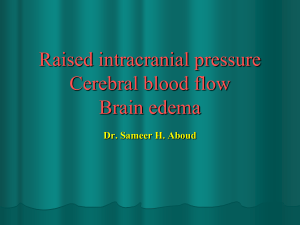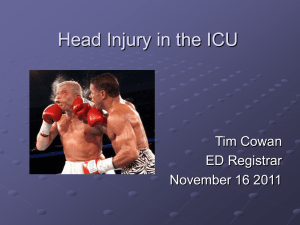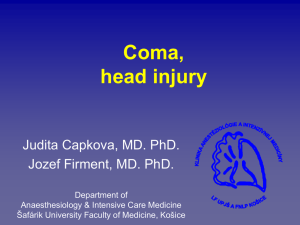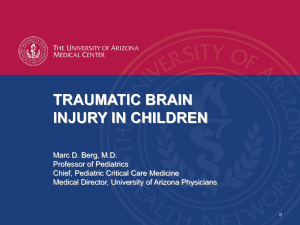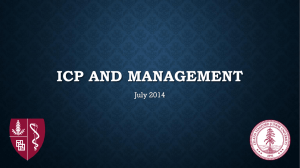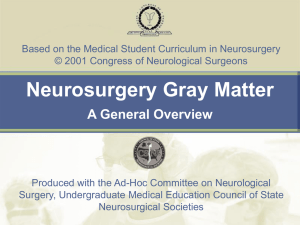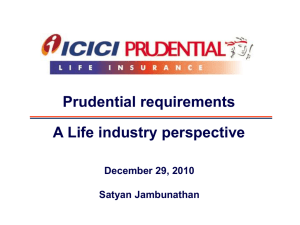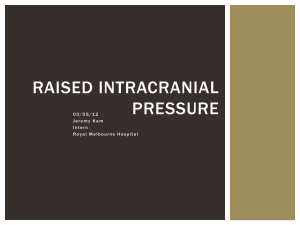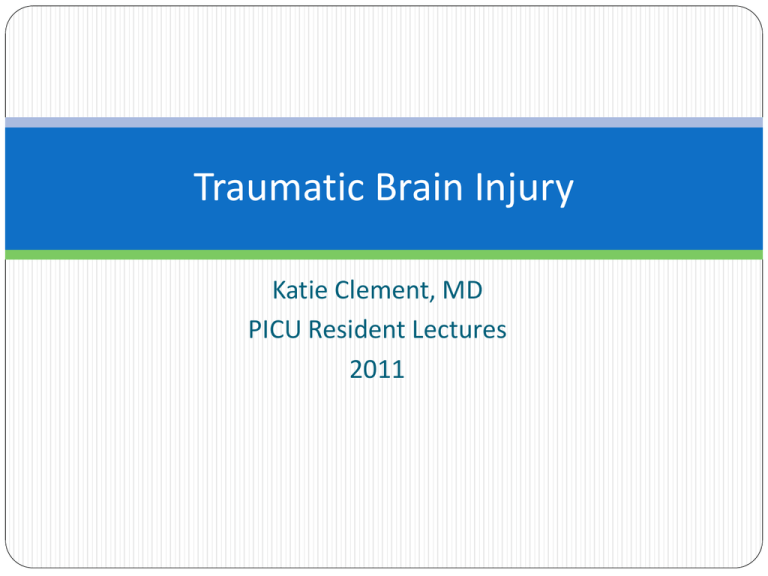
Traumatic Brain Injury
Katie Clement, MD
PICU Resident Lectures
2011
Objectives
Understand the mechanisms of Pediatric Traumatic
Brain Injury
Understand the pathophysiology of TBI
Understand the management of TBI
Overview
Epidemiology
Injury is leading cause of death for children
Krug EG et al. Am J Public Health. 2000.
40% of those are from TBI
Langlois JA et al. Centers for Disease Control & Prevention. 2006.
Mortality between 17 – 33%
White JR et al. CCM. 2001.
Most common cause of death & disability in childhood in
developed countries
Krug EG et al.
3000 children die each year from TBI in the US
Langlois JA et al.
GCS
Severity of TBI is defined by the GCS Score
Mild
GCS 13-15
Moderate
GCS 9-12
Severe
GCS <9
GCS
Motor Response
Total score ranges from 3 - 15
Verbal Response
Oriented
(age appropriate vocalization,
smiling, cooing, tracks objects)
5
Confused, disoriented
(cries, irritable)
4
Inappropriate words
(cries to pain)
3
6
Localizes pain
5
Withdraws to pain
4
Abnormal flexion to pain
(decorticate posturing)
3
Abnormal extension to pain
(decerebrate posturing)
2
No response
1
Eye Opening
Incomprehensible sounds (moans 2
to pain)
No response
Follows commands
1
Spontaneous
4
To command
3
To pain
2
No eye opening
1
Pathophysiology
Effects of Trauma
Increase in volume of any or all intracranial
components
Uncoupling of cerebral blood flow & metabolic activity
(loss of autoregulation) can lead to excessive CBF
Increased CSF production in response to increased
CBF
Hypercapnia or hypoxia (cause vasodilation &
increased CBF)
Herniation, brain swelling, subarachnoid hemorrhage
may obstruct flow of CSF
Hematomas, contusions, edema may increase
intracranial volume
Definition of ICP
ICP = ICP vascular + ICP CSF
Used to estimate cerebral perfusion pressure
CPP = MAP – mean ICP
CPP: Cerebral Perfusion Pressure
ICP: Intracranial Pressure
MAP: Mean Arterial blood Pressure
Normal Values
ICP is typically ≤ 15 mmHg in adults and lower in
children & newborns
ICP ≥ 20 mmHg is pathologic in adults
Physiologic events such as sneezing, coughing, Valsalva
will transiently raise ICP as well
CPP normals for adults range from 50 – 70 mmHg
Not well established in children, likely 40 – 60 mmHg
depending on age
When CPP falls below a critical level, brain receives
inadequate blood flow
Intracranial Pressure
The intracranial compartment has a fixed internal
volume
Brain parenchyma – 80%
CSF – 10%
Blood – 10%
ICP is a function of the volume & compliance of each
component
The Monroe-Kellie Doctrine
Monroe-Kellie Principle
Intracranial compensation for an expanding mass lesion
Data from Pathophysiology and management of the intracranial vault. In: Textbook of Pediatric Intensive Care, 3rd
ed, Rogers, MC (Ed), Williams and Wilkins 1996. p. 646; figure 18.1.
The relationship between intracranial volume and pressure is nonlinear
An initial increase in volume results in a small increase in pressure because of intracranial compensation (blue line). Once intracranial
compensation is exhausted, additional increases in intracranial volume result in a dramatic rise in intracranial pressure (red line).
Cerebral Edema
Diffuse swelling more common among infants and
children compared to adults
Lang DA. J Neurosurg 1994
Infant skull is more compliant, tolerates significant
deformation without fracture
Coats B. J Neurotrauma 2006
Brain atrophy begins in young adulthood and allows
for more room in the adult skull for brain to expand
Kochanek PM. Dev Neurosci 2006
Cerebral Edema
Worsened with hypoxia & hypoperfusion
Types of edema:
Vasogenic- breakdown of the blood-brain barrier
Cytotoxic- cellular swelling
Interstitial- periventricular exudation of cerebrospinal
fluid through the ependymal lining
Osmotic- movement of water into the interstitial spaces
induced by osmotically active products of tissue injury
and blood clot
Cerebral Autoregulation
Often impaired in children with TBI
Impaired autoregulation is associated with worse
outcome
Cerebral autoregulation in hypertension
Kaplan, NM, Lancet 1994
2 Insults
Primary Injury
Direct injury to brain parenchyma
Blunt force: Contusions, hematomas
Acceleration-deceleration: physical shearing or tearing
of axons
http://www.tbilawyers.com/diffuse-axonal-injury.html
Secondary Injury:
Potentially avoidable or treatable
Hypoxemia
Hypotension
Elevated ICP
Hypercarbia
Hyper- & Hypoglycemia
Electrolyte abnormalities
Enlarging hematomas
Coagulopathy
Seizures
Hyperthermia
Endogenous cascade of cellular & biochemical events
Occurs within minutes and continues for months after initial
injury
Leads to neuronal cell death
Diffuse Axonal Injury
Widespread damage to axons in the white matter
Corpus callosum
Basal ganglia
Periventricular white matter
Caused by
Hypoxic-ischemic injury
Calcium & ion flux
Mitochondrial & cytoskeletal dysfunction
A major cause of morbidity in pediatric TBI
More extensive DAI associated with worse outcome
Evaluation
Initial Evaluation
Don’t forget standard trauma protocols:
Primary Survey
ABCs!
Secondary Survey
History
Mechanism of injury
Loss of consciousness + duration
Vomiting
Headache
One of the earliest symptoms of increased ICP
Progression of symptoms
Physical Exam—General
Hypoxia & hypotension should be immediately
identified and treated
Respiratory depression, bradycardia, and/or
hypertension may indicate impending herniation and
also requires prompt treatment
Maintain C-spine immobilization
Neuro exam
Assign a GCS
Level of consciousness
Pupils
Extraocular movements
Funduscopic exam
Brainstem reflexes
DTRs
Response to pain
Battle Sign
Raccoon Eyes
CSF Rhinorrhea
Setting-Sun Sign
Late sign of increased
intracranial pressure
Pressure on cranial nerves
III, IV, and VI forces the eyes
downward, revealing a rim of
sclera above the irises.
Funduscopic Exam
www.dontshake.org
http://cloud.med.nyu.edu/modul
es/pub/neurosurgery/cranials.ht
ml
Types of Herniation
a) Subfalcine : uneven, one-sided expansion of a cerebral hemisphere that pushes a
portion of the brain tissue (cingulate gyrus) under the falx cerebri
b) Uncal: medial temporal lobe is pushed against the tentorium. Can compress
brainstem in severe cases
c) Central transtentoral : downward pressure centrally, can cause bilateral uncal
herniation.
d) Extracranial : brain tissue pushes through an opening in the cranial cavity either
surgically or by trauma
e) Tonsillar : swelling or bleeding in the cerebellum pushes the cerebellar tonsils
downward into the foramen magnum. Life threatening b/c can compress the
brainstem
Signs of herniation
Uncal herniation:
Third cranial nerve palsy
Hemiplegia
Progressive changes in respiratory pattern, pupil size,
vestibuloocular reflexes, posturing
Cushing’s Triad
Hypertension
OCCURS LATE!!
Bradycardia
Slow, irregular respirations
Mydriasis
Can be associated with
CN III injury
Uncal herniation can
cause unilateral
mydriasis & ptosis
Labs
Depends on type & extent of injury
Minimum: hct, T&S, UA
Useful in TBI:
Glucose
Hyperglycemia is a poor prognostic indicator
Electrolytes w/ osmolarity
Coags
DIC is associated with poor outcomes
Chiaretti A. Childs Nerv Syst 2002.
Imaging
CT is preferred initial imaging
Following initial stabilization
Focal injuries are readily diagnosed by CT
Patients with DAI may have normal CT scans
Most common finding is diffuse cerebral swelling
Subdural
hematoma
www.neurosurgery.com.sg
Epidural
hematoma
http://www.hawaii.edu/medicine/pedi
atrics/pemxray/v5c07.html.
http://uwmedicine.washington.edu/patientcare/our-services/medical-services/strokecenter/pages/articleview.aspx?subid=83
Diffuse Axonal Injury (on MRI)
http://neuroradiologyonthenet.blogspot.com/
2008/05/diffuse-axonal-injury-dai.html
Management
Goals
Minimize ICP elevation
Maintain adequate CPP to prevent secondary ischemic
injury
CPP goal for adults should be 60 – 70 mmHg
Minimum acceptable for children is not defined, but
recommended 40 – 65 mmHg depending on age.
Studies show that CPP from 40 – 65 improves outcome
CPP < 40 associated with poor outcome
ICP goal typically < 20 mmHg
Adelson PD. PCCM. 2003
Initial Decisions
Immediate NSGY consultation
Quickly identify focal injuries that require
neurosurgical intervention
GCS ≤ 8 or GCS 9-12 and deteriorating/not protecting
airway require intubation
Recognize signs of herniation & treat if present
Assure adequate oxygenation, breathing, BP
Give hyperosmolar therapy
Provide mild hyperventilation
Immediate NSGY evaluation
Airway & Breathing
Advanced airway management necessary if
Decreasing level of consciousness (GCS ≤ 8)
Marked respiratory distress
Hemodynamic instability
Other considerations
C-spine immobilization must be maintained
Nasotracheal intubation contraindicated with midface
trauma or basilar skull fracture
Cuffed tubes to protect from aspiration
Rapid Sequence Intubation
Pretreat with lidocaine to minimize increase in ICP
Preoxygenation
Etomidate & Thiopental have neuroprotective
properties
? Risk of increased ICP with succinylcholine
Rocuronium may be preferred
Avoid high PEEP and PIP because they will increase
intrathoracic pressure and may impede cerebral venous
drainage.
Monitoring
Standard VS: HR, BP, Pulse Ox
Capnography
To monitor ventilation & avoid excessive
hyperventilation
ICP monitoring recommended for abnormal head CT &
initial GCS 3 – 8
Interventions used to decrease ICP require accurate
and continuous ICP monitoring!!
ICP Monitoring
Indications
Traumatic brain injury (GCS < 8 with focal findings on CT)
Obstructive intracranial lesion
Post operative edema
Contraindications
Coagulopathy: i.e. high risk of hemorrhage
Relative Indications
Metabolic cerebral edema
ICP Monitoring Options
External Ventricular
Device (EVD) both
diagnostic and
therapeutic
Intra-parenchymal
device: Diagnostic guide
to therapy
Others: diagnostic
Management of ICP
First tier therapies
Maintain CPP
Sedation & analgesia
HOB at 30 degrees
Ventriculostomy drain
Neuromuscular blockade
Hyperosmolar therapy (mannitol & hypertonic saline)
Mild hyperventilation
Second tier therapies
Hyperventilation
Decompressive craniectomy
High dose barbiturates
Hypothermia (32 – 34 degrees)
Hyperventilation
Reduces ICP
May be harmful with routine use
Results in hypocapnia
Skippen P. CCM 1997.
Vasoconstriction
Decreased cerebral blood flow
Associated with poor outcomes among children with TBI [30]
Adelson PD. Pediatr Neurosurg 1997.
PCO2 < 30 mmHg associated with increased mortality
Curry R. PCCM 2008.
Maintain PaCO2 between 35 – 38 mmHg unless signs
of impending herniation
Initial Fluid Management
Restore volume—Isotonic fluids preferred
Blood products as indicated
Outcomes are poor for children who are hypotensive
at initial evaluation
White JR. CCM 2001
Vavilala MS. J Trauma 2003
Luerssen TG. J Neurosurg 1988
Pigula FA. J Pediatr Surg 1993
Systolic blood pressure should be maintained above
the 5th percentile for age and sex at the minimum
Adelson PD. PCCM. 2003
Improved outcomes for patients with initially higher
blood pressure
Head Positioning
Maintain head in neutral position to
avoid jugular venous obstruction
As head-up position is increased, ICP may be
reduced, but beyond 30o heads-up CPP is likely
compromised. Second source: Durward, QJ,
Amadner, AL, Del Maestro, RF, et al: Cerebral
and vascular responses to changes in head
elevation in patients with intracranial
hypertension, J Neurosurg 59: 938, 1983.
Sedation and Neuromuscular Blockade
Maintain adequate analgesia to blunt response to
noxious stimuli
Maintain sedation to permit controlled ventilation
Cerebral oxygen consumption may be decreased in
patients receiving neuromuscular blockade
Vernon DD. CCM 2000
Antiseizure Prophylaxis
Reduces the incidence of early posttraumatic seizures
among children with severe TBI Schierhout G. Cochrane Database Syst Rev 2001
Seizures increase metabolic demand and increase ICP
Leads to secondary brain injury
Retrospective studies demonstrate improved
outcomes among children with TBI treated with
anticonvulsants Tilford JM. CCM 2001
Recommend anticonvulsants during the first week
following TBI if high risk
Penetrating skull fractures, hematomas, masses, bleeds
Adelson PD et al. PCCM 2003
Temperature control
Aggressively prevent & treat hyperthermia
Raises metabolic demand & ICP
Hypothermia decreases cerebral metabolism and may
reduce CBF & ICP
(Considered second tier therapy)
Controversial
One multicenter trial showed harm
Control shivering with muscle relaxants
Hyperosmolar Therapy
Establishes an osmotic gradient between plasma and
parenchymal tissue
Reduces brain water content
Extensive research shows that it effectively decreases
ICP in children with TBI
Mannitol
Decreases ICP effectively based on extensive clinical
experience
Dose 0.25 – 1 g/kg IV
Adverse effects: hyperosmolarity, hypovolemia,
electrolyte imbalance
Nephrotoxicity can occur, especially if patients are
hypovolemic
Don’t typically use if serum osmolarity >320
Adelson PD et al. PCCM 2003.
Hypertonic Saline
Can be administered as a bolus or as an infusion
Optimal dosing not clear
3% saline commonly used as bolus of 2-6 ml/kg
Continuous infusion of 0.1 – 1 ml/kg/hr also described
Effective at reducing ICP in small randomized trials &
Huang SJ. Surg Neurol 2006.
observational reports
Does not cause profound osmotic diuresis, so
decreased risk of hypovolemia
Adverse effects:
Rebound intracranial hypertension
Central pontine myelinolysis (theoretical, not reported)
Qureshi AI. CCM 2000.
Glucose Control
Hyperglycemia associated with poor outcomes
Marker for severity of injury
Worsens brain tissue lactic acidosis
Recommend to keep glucose level at least less than
200
Adelson PD. PCCM 2003.
Corticosteroids
No benefit in trauma
Large, prospective multicenter trial demonstrated
increased mortality among patients with acute TBI
who received steroids
Useful only for vasogenic edema from tumors because
they stabilize the BBB
Barbiturate coma—second tier therapy
Used if ICP refractory to other modalities
Pentobarbital typically used
Decreases cerebral metabolic rate and thus cerebral
blood flow
May have protective effects during periods of hypoxia
and/or hypoperfusion
Cardiac suppression, hypotension
Treat with fluids & inotropic support
No evidence for prophylactic use
Other second tier therapies
Aggressive hyperventilation (PaCO2 < 30)
Recommend brain tissue oxygenation monitoring or jugular
venous O2 saturation or CBF monitoring
Decompressive craniectomy
Ideal patient has had no episodes of ICP > 40 before surgery,
have had a GCS > 3 at some point
Evolving herniation syndrome within 48 hrs of injury
Lumbar CSF drainage
Not common
Must have a functioning EVD in place, open basal cisterns, no
mass effect or shift on CT (to avoid herniation)
Hypothermia
Core temp 32 – 34 degrees
More studies needed
Management Algorithm
Adelson PD et al. PCCM 2003
Adelson PD et al. PCCM 2003
Adelson PD et al. PCCM 2003
Second Tier Therapies
Adelson PD et al. PCCM 2003
Summary
Have Neurosurgery involved EARLY
For surgical intervention & monitor placement
Keep ICP <20 mmHg
Keep CPP appropriate for age (> 40 – 60 mmHg)
References
Vavilala MS, Waitayawinyu P, Dooney NM. Initial approach to severe traumatic
brain injury in children. www.uptodate.com 2011.
Huh JW, Raghupathi R. New concepts in treatment of pediatric traumatic brain
injury. Anesthesiology Clin 2009:27;213-240.
Brasher WK. Elevated intracranial pressure in children. www.uptodate.com
2011.




